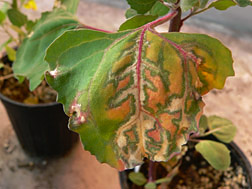Plant Disease Detectives I.D. New Sugar Beet Virus
|
|
Beet necrotic yellow vein virus (BNYVV) has been the top soilborne nemesis of sugar beets, shrinking their sucrose yields by up to 40 percent. The disease it causes, rhizomania (“crazy root”), is so named for the thick beard of feathery hairs that sprout from the taproot of infected beets.
Now, it turns out, BNYVV may have a partner in crime—one that hides within rhizomania’s symptoms and itself is damaging to beets. Plant pathologist John J. Weiland at ARS’s Red River Valley Agricultural Research Center at Fargo, North Dakota, and colleague Rebecca Larson at the ARS Crops Research Laboratory at Fort Collins, Colorado, surmised as much after collecting diseased sugar beet plants in October 2005 from a commercial field near Greeley, Colorado. Most of the plants’ roots sported the telltale beard, but strangely enough, the virus wasn’t there—at least, as far as the researchers’ antibody-based test could determine.
Weiland’s team inoculated the leaves of the common weed Chenopodium quinoa and a sugar beet hybrid with extracts from the infected root specimens. Yellow lesions formed on the inoculated leaves 5 days later—sooner than if the culprit had been BNYVV or related viruses.
While helping search for BNYVV with a transmission electron microscope, collaborating North Dakota State University plant pathologist Tom Freeman discovered hexagonal particles of a mystery virus embedded within the cytoplasm of the infected plants’ cells. After purification of the virus, with the aid of collaborator Mike Edwards in ARS’s Cereal Crops Research Unit at Fargo, Weiland cloned a DNA copy of the viral genome, which was sequenced. He then conducted a search of published viral genomes—and their signature gene products—for a match.
This led to the beet black scorch virus (BBSV), known only to occur in China. With sequence in hand, the researchers honed in on specific portions of the genomes of the Greeley specimens—particularly regions encoding for coat protein. The approach showed that the amino acid sequences making up their coat proteins were 97 percent identical.
“To our knowledge,” says Weiland, “this constitutes the first report of BBSV outside of China,” where outbreaks typically associated with rhizomania are blamed for major sugar beet losses. In northern China, the virus purportedly inflicts black, scorchlike marks on sugar beet leaves. But Weiland’s team observed rhizomanialike symptoms in the Colorado beets in 2005 and in a field survey begun in August 2006 that ranged from Michigan to California. The difference in symptoms, he says, may be due to multiple changes across the U.S. and Chinese isolates’ genomes.
Weiland is currently working with ARS plant pathologists in Salinas, California, to figure out whether BBSV does in fact cause rhizomania symptoms or other harm to U.S. beets. “Even if it’s not causing harm by itself, it could be acting with other viruses or pathogens in causing severe disease,” notes Weiland.—By Jan Suszkiw, Agricultural Research Service Information Staff.
This research is part of Plant Diseases, an ARS National Program (#303) described on the World Wide Web at www.nps.ars.usda.gov.
To reach scientists mentioned in this article, contact Jan Suszkiw, USDA-ARS Information Staff, 5601 Sunnyside Ave., Beltsville, MD 20705-5129; phone (301) 504-1630, fax (301) 504-1486.
"Plant Disease Detectives I.D. New Sugar Beet Virus" was published in the March 2007 issue of Agricultural Research magazine.







